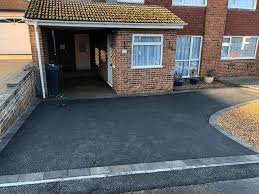Repairing cracks in your driveway is essential to maintaining its longevity and appearance. If left untreated, small cracks can widen and lead to more significant issues like potholes or surface erosion. If you want to make your tarmac coventry Beautiful we are here.Here are some effective tips for repairing cracks in different types of driveways:
1. Identify the Type of Crack
- Hairline Cracks: Small, surface-level cracks less than 1/8 inch wide. These can usually be repaired with simple crack fillers.
- Larger Cracks: Cracks wider than 1/4 inch may require more intensive repairs, such as using patching compounds or concrete resurfacing.
- Alligator Cracks: These are extensive, interconnected cracks resembling alligator skin. They typically indicate structural issues and may require professional repair or resurfacing.
2. Clean the Cracks Thoroughly
- Remove Debris: Use a wire brush, screwdriver, or chisel to clear out dirt, gravel, weeds, and any loose material from the crack.
- Pressure Wash: Use a pressure washer or hose to remove any remaining dust and debris. Let the area dry completely before starting the repair.
- Use a Crack Cleaner Tool: For deep or narrow cracks, a crack cleaner tool can help remove stubborn materials stuck inside.
3. Choose the Right Repair Material
- For Asphalt Driveways:
- Asphalt Crack Filler: Use a rubberized asphalt crack filler for hairline or small cracks. These fillers come in pourable or caulking gun versions for easy application.
- Cold Patch Asphalt: For larger cracks, apply a cold patch asphalt mix. This is especially useful for cracks wider than 1/2 inch.
- For Concrete Driveways:
- Concrete Crack Filler: Use a concrete-specific crack filler for hairline cracks. These fillers expand slightly as they dry, sealing the crack tightly.
- Concrete Patch Compound: For larger cracks or holes, a concrete patch compound can be applied and smoothed out for an even surface.
4. Use a Backer Rod for Deep Cracks
- What It Is: A backer rod is a foam rod used to fill deep cracks, reducing the amount of filler needed.
- How to Use: Push the backer rod into the crack until it is about 1/4 inch below the surface, then apply crack filler or patch over it. This method helps prevent the filler from sinking as it dries and creates a more solid repair.
5. Apply the Crack Filler
- Hairline Cracks:
- Pour the crack filler directly into the crack, using a caulking gun or squeeze bottle for smaller cracks.
- Use a putty knife or trowel to smooth the filler, ensuring it sits slightly above the surrounding surface (it will settle as it dries).
- Larger Cracks:
- For cracks over 1/4 inch wide, fill in layers. Apply the filler or patching compound, let it set, and repeat until the crack is filled.
- Use a trowel to smooth the surface for a professional finish.
6. Compact the Filler
- Why It’s Important: Compacting ensures the filler adheres properly and doesn’t settle too much over time.
- How to Compact: Use a tamper or heavy object to press down on the filler. For cold patch asphalt, compacting is crucial to ensure a strong bond.
7. Let the Repair Cure Properly
- Drying Time: Allow the filler or patch to dry according to the manufacturer’s instructions, which is usually 24 to 48 hours. Avoid driving or walking on the driveway during this time.
- Protect from Moisture: Ensure the weather will remain dry while the filler cures, as rain or moisture can prevent it from setting properly. You can cover the repaired area with plastic sheeting if rain is expected.
8. Seal the Driveway After Repair
- Why Seal?: Applying a driveway sealer after repairing cracks helps protect the surface from further damage caused by weather, UV rays, and traffic.
- Asphalt Driveways: Use a rubberized asphalt sealer to coat the entire driveway, filling in small imperfections and adding a protective layer.
- Concrete Driveways: Use a concrete sealant to protect the surface and extend the life of your repairs.
- When to Seal: Wait at least 1 to 2 months after repairing cracks before sealing, allowing ample time for the filler or patch to cure completely.
